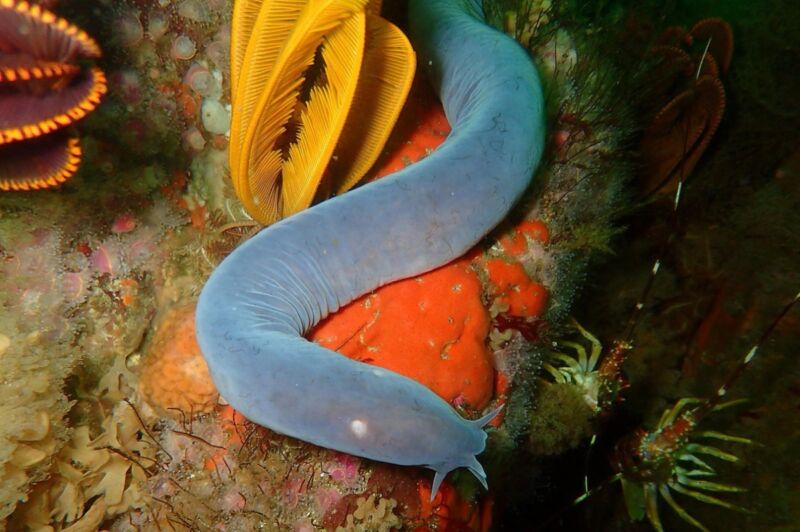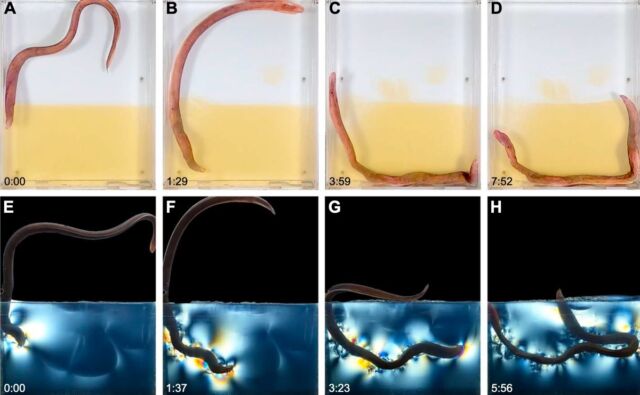How hagfish burrow into deep-sea sediment
[ad_1]

The humble hagfish is an ugly, gray, eel-like creature best known for its ability to unleash a cloud of sticky slime onto unsuspecting predators, clogging the gills and suffocating said predators. That’s why it’s affectionately known as a “snot snake.” Hagfish also love to burrow into the deep-sea sediment, but scientists have been unable to observe precisely how they do so because the murky sediment obscures the view. Researchers at Chapman University built a special tank with transparent gelatin to overcome this challenge and get a complete picture of the burrowing behavior, according to a new paper published in the Journal of Experimental Biology.
“For a long time we’ve known that hagfish can burrow into soft sediments, but we had no idea how they do it,” said co-author Douglas Fudge, a marine biologist who heads a lab at Chapman devoted to the study of hagfish. “By figuring out how to get hagfish to voluntarily burrow into transparent gelatin, we were able to get the first ever look at this process.”
As previously reported, scientists have been studying hagfish slime for years because it’s such an unusual material. It’s not like mucus, which dries out and hardens over time. Hagfish slime stays slimy, giving it the consistency of half-solidified gelatin. That’s due to long, thread-like fibers in the slime, in addition to the proteins and sugars that make up mucin, the other major component. Those fibers coil up into “skeins” that resemble balls of yarn. When the hagfish lets loose with a shot of slime, the skeins uncoil and combine with the salt water, blowing up more than 10,000 times its original size.
From a materials standpoint, hagfish slime is fascinating stuff that might one day prove useful for biomedical devices, or weaving light-but-strong fabrics for natural Lycra or bulletproof vests, or lubricating industrial drills that tend to clog in deep soil and sediment. In 2016, a group of Swiss researchers studied the unusual fluid properties of hagfish slime, specifically focusing on how those properties provided two distinct advantages: helping the animal defend itself from predators and tying itself in knots to escape from its own slime.
Hagfish slime is a non-Newtonian fluid and is unusual in that it is both shear-thickening and shear-thinning in nature. Most hagfish predators employ suction feeding, which creates a unidirectional shear-thickening flow, the better to clog the gills and suffocate said predators. But if the hagfish needs to get out of its own slime, its body movements create a shear-thinning flow, collapsing the slimy network of cells that makes up the slime.
Fudge has been studying the hagfish and the properties of its slime for years. For instance, way back in 2012, when he was at the University of Guelph, Fudge’s lab successfully harvested hagfish slime, dissolved it in liquid, and then “spun” it into a strong-yet-stretchy thread, much like spinning silk. It’s possible such threads could replace the petroleum-based fibers currently used in safety helmets or Kevlar vests, among other potential applications. And in 2021, his team found that the slime produced by larger hagfish contains much larger cells than slime produced by smaller hagfish—an unusual example of cell size scaling with body size in nature.
A sedimentary solution
This time around, Fudge’s team has turned their attention to hagfish burrowing. In addition to shedding light on hagfish reproductive behavior, the research could also have broader ecological implications. According to the authors, the burrowing is an important factor in sediment turnover, while the burrow ventilation changes the chemistry of the sediment such that it could contain more oxygen. This in turn would alter which organisms are likely to thrive in that sediment. Understanding the burrowing mechanisms could also aid in the design of soft burrowing robots.

D.S. Fudge et al., 2024
But first Fudge’s team had to figure out how to see through the sediment to observe the burrowing behavior. Other scientists studying different animals have relied on transparent substrates like mineral cryolite or hydrogels made of gelatin, the latter of which has been used successfully to observe the burrowing behavior of polychaete worms. Fudge et al. opted for gelatin as a sediment replacement housed in three custom transparent acrylic chambers. Then they filmed the gelatin-burrowing behavior of 25 randomly selected hagfish.
This enabled Fudge et al. to identify two distinct phases of movement that the hagfish used to create their u-shaped burrows. First there is the “thrash” stage, in which the hagfish swims vigorously while moving its head from side to side. This not only serves to propel the hagfish forward, but also helps chop up the gelatin into pieces. This might be how hagfish overcome the challenge of creating an opening in the sediment (or gelatin substrate) through which to move.
Next comes the “wriggle” phase, which seems to be powered by an “internal concertina” common to snakes. It involves the shortening and forceful elongation of the body, as well as exerting lateral forces on the walls to brace and widen the burrow. “A snake using concertina movements will make steady progress through a narrow channel or burrow by alternating waves of elongation and shortening,” the authors wrote, and the loose skin of the hagfish is well suited to such a strategy. The wriggle phase lasts until the burrowing hagfish pops its head out of the substrate. The hagfish took about seven minutes or more on average to complete their burrows.
Naturally there are a few caveats. The walls of the acrylic containers may have affected the burrowing behavior in the lab, or the final shape of the burrows. The authors recommend repeating the experiments using sediments from the natural habitat, implementing X-ray videography of hagfish implanted with radio markers to capture the movements. Body size and substrate type may also influence burrowing behavior. But on the whole, they believe their observations “are an accurate representation of how hagfish are creating and moving within burrows in the wild.”
DOI: Journal of Experimental Biology, 2024. 10.1242/jeb.247544 (About DOIs).
[ad_2]
Read More:How hagfish burrow into deep-sea sediment

Comments are closed.